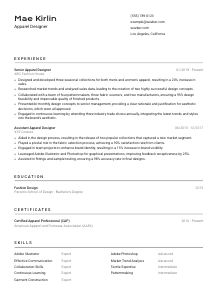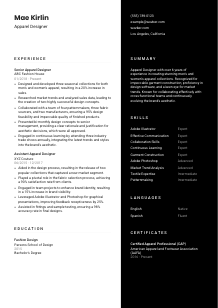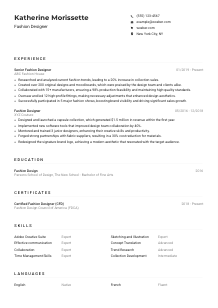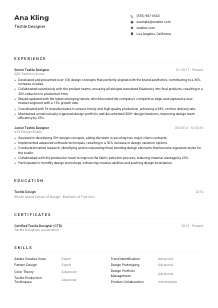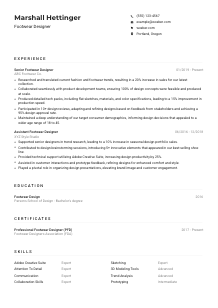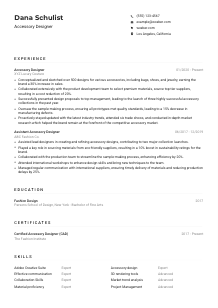Apparel Designer Resume Example
Sketching couture, but your resume seems off the hanger? Button up with this Apparel Designer resume example, drafted with Wozber free resume builder. Grasp how to tailor your textile talents to align with job specs, weaving a career as intricate as your threadwork!

How to write an Apparel Designer Resume?
Embarking on the quest to secure your dream role as an Apparel Designer? Consider your resume as the first garment in your collection, a piece that needs to not only fit the job description perfectly but also showcase your unique design philosophy. With the right tools, such as Wozber's free resume builder, crafting an ATS-compliant resume that highlights your expertise and aligns with the specific requirements of your desired role becomes a streamlined and inspiring process. Let's stitch together a resume that reflects your creativity and skill.
Personal Details
The 'Personal Details' section is like the label on a designer garment - it introduces the brand (you) and sets the tone for the craftsmanship (your skills and experiences). Tailor this section to catch the eye of the hiring manager right from the start.
1. Make Your Name a Statement
Think of your name as the logo of your personal brand. It should be prominently displayed in a clear, bold font at the top of your resume. This ensures that your identity sticks in the mind of the reader, much like a well-crafted logo does.
2. Incorporate the Job Title
Mirror the job title "Apparel Designer" directly below your name, akin to declaring your field of expertise. This subtle alignment with the job description sends a message of suitability and focus.
3. List Essential Contact Details
- Phone Number: This is your direct line. Make sure it's correct and professional. A missed digit could mean a missed opportunity.
- Professional Email Address: Your email should be simple and professional, usually a variation of your name. Avoid nicknames or outdated email providers that might not reflect well on your digital savviness.
4. Confirm Your Location
Given that the job requires being located in Los Angeles, California, prominently stating your location aids in confirming your eligibility, especially for localized positions that value community understanding and network.
5. Add a Professional Profile or Website
If you have a portfolio or LinkedIn profile that showcases your work, include it. This offers a tangible proof of your style and skills, much like a lookbook would for your collection.
Takeaway
Your personal details are not just formalities; they are your introduction to the hiring manager. Ensure each piece of information places you in the best light, befitting the Apparel Designer role you aspire to. Think of it as creating the perfect first impression.





Experience
Your experience section is where you get to showcase the collections you've designed over the years. Each role you've had is a season in your career, boasting of unique designs and successes. Let's walk through curating your best work to align with the job description.
- Designed and developed three seasonal collections for both men's and women's apparel, resulting in a 20% increase in sales.
- Researched market trends and analyzed sales data, leading to the creation of two highly successful design concepts.
- Collaborated with a team of four patternmakers, three fabric sourcers, and two manufacturers, ensuring a 95% design feasibility and impeccable quality of finished products.
- Presented bi‑monthly design concepts to senior management, providing a clear rationale and justification for aesthetic decisions, which were all approved.
- Engaged in continuous learning by attending three industry trade shows annually, integrating the latest trends and styles into the brand's aesthetic.
- Aided in the design process, resulting in the release of two popular collections that captured a new market segment.
- Played a pivotal role in the fabric selection process, achieving a 90% satisfaction rate from clients.
- Engaged in team projects to enhance brand identity, resulting in a 15% increase in brand visibility.
- Leveraged Adobe Illustrator and Photoshop for graphical presentations, improving feedback receptiveness by 25%.
- Assisted in fittings and sample testing, ensuring a 98% accuracy rate in final designs.
1. Understand the Job
Begin with dissecting the job description, identifying keywords and phrases. For instance, "design and develop seasonal collections" and "collaborate closely with patternmakers" are aspects you'd want your resume to echo, demonstrating your direct relevance.
2. Chronologically Arrange Your Collections
List your experiences starting with the most recent. Include your title, the name of the company, and the timeframe you were there. Think of it as organizing your portfolio, leading with your latest and most compelling work.
3. Detail Your Design Achievements
For each position, highlight specific accomplishments, especially those that resonate with the job description. Did you increase sales with your collections? How did you contribute to the design process? Specific examples convey the impact of your creativity and technical skills.
4. Quantify Your Fashion Statements
Whenever possible, attach numbers to your achievements. Perhaps your collection led to a 20% increase in sales, or you collaborated with a team of four patternmakers. These details provide a tangible measure of your success.
5. Highlight Relevant Design Experiences
Focus on the experiences that most closely align with the job. While your stint as a window dresser might have honed your eye for display, prioritize your direct involvement in apparel design to keep your resume as relevant as possible.
Takeaway
The experience section is your runway. Each role you list should illustrate your journey as an Apparel Designer, displaying your development, creativity, and the tangible successes of your collections. Ensure your career's narrative is as compelling as your designs.
Education
In the world of fashion, your education is not just about the institutions you've attended; it's a reflection of your foundational knowledge in design principles, textiles, and garment construction. Let's draft an education section that showcases your preparedness for the role.
1. Highlight Essential Educational Background
"Bachelor's degree in Fashion Design, Textile Design, or related field." If your degree aligns directly as above, it's crucial to list it prominently. This confirms you possess the necessary academic foundation for the Apparel Designer role.
2. Keep It Clean and Precise
Your education section should be straightforward. List your degree, the institution where you earned it, and your graduation year. This clarity ensures the focus remains on the quality of your education, not how it's presented.
3. Tailor Degree Details
If you studied something directly relevant to the job, like Fashion Design, make sure it's evident. Titles matter here. They can quickly show a hiring manager that your educational background is a perfect fit for their design team.
4. Mention Pertinent Courses
For newer designers, relevant coursework can serve as practical experience. Did you excel in textile sciences or fashion merchandising? Highlighting these courses can fill in gaps in your experience with your knowledge depth.
5. Add Other Educational Highlights
If you achieved honors, participated in fashion shows, or were part of design-related organizations, include them. Such details add color to your educational background, showing a deeper engagement with your field beyond just your coursework.
Takeaway
Consider the education section of your resume as the stitching that holds your fabric of experiences together. It should firmly establish the quality and relevancy of your educational background for an Apparel Designer role, complemented by any additional achievements that portray your commitment and passion.
Certificates
In fashion, staying relevant means continuously evolving and learning. Certificates are your proof of ongoing education and specialization. Let's embellish your resume with certifications that underline your commitment to your craft.
1. Identify Relevant Certifications
While the job description might not demand specific certificates, having them can set you apart. A Certified Apparel Professional (CAP) designation, for example, showcases a dedication to the industry's standards and practices.
2. Choose Quality Over Quantity
Listing numerous certifications might dilute their impact. Select those most closely related to apparel design, highlighting your specialized skills or knowledge areas. This conciseness ensures hiring managers notice your most relevant qualifications first.
3. Be Clear About Dates
If your certificate has an expiration date or was recently obtained, include these details. This information is particularly pertinent if the certifications highlight skills that are currently in-demand or showcase your commitment to staying up-to-date in your field.
4. Keep Your Certifications Current
Fashion is an ever-evolving field, and your certificates should reflect your ongoing engagement with the industry's changes. Regularly review, and renew if necessary, your certifications to ensure they remain relevant and reflect your continuous learning.
Takeaway
Think of your certificates as the intricate details in a garment – they may not be the first thing to catch the eye, but upon closer inspection, they significantly elevate the overall design. Ensure your certificates highlight your advanced skills and dedication to the Apparel Designer role.
Skills
Your skills section is like the fabric swatches of your resume: a collection of your finest qualities as an Apparel Designer. Let's select and display the skills that not only match the job requirements but also demonstrate your command over the craft.
1. Analyze the Job Posting
Start by deciphering the skills listed in the job description, such as proficiency in Adobe Illustrator and a strong understanding of garment construction. These are non-negotiable skills that your resume must reflect.
2. Prioritize Applicable Skills
Identify both your hard and soft skills that match those requested in the job posting. Expertise in Adobe Illustrator and Photoshop, effective communication, and collaboration skills are essential to highlight, given their direct mention in the job description.
3. Organize Your Skill Set
Keep your skills section focused and neat. Listing too many can be overwhelming and dilute the impact of your core capabilities. Aim for a balance of technical skills and soft skills that reinforce your proficiency as an Apparel Designer.
Takeaway
Just as you would carefully select fabrics for a garment, choose the skills for your resume that best represent your proficiency and suitability for the Apparel Designer role. Each skill you list is a thread in the overall texture of your professional identity.
Languages
Fluency in multiple languages can be a vibrant thread in the tapestry of your resume, especially in a globalized industry like fashion. Let's thread in your linguistic abilities, ensuring they complement the palette of your skills and qualifications.
1. Reflect on Job Necessities
Firstly, verify if specific languages are mentioned in the job description. For the Apparel Designer role, strong English fluency was a requirement, underlining the importance of listing English at a native or fluent proficiency level.
2. Spotlight Essential Languages
Position the languages essential for the role at the forefront of this section. Your fluency in English, given its importance to the role, should be immediately visible to the reader.
3. Elaborate on Additional Languages
While the role may not explicitly require other languages, being multilingual is a testament to your ability to communicate in a diverse work environment. List these languages with an honest assessment of your proficiency.
4. Accurately Assess Your Fluency
Be precise in describing your language skills. Whether you're native, fluent, intermediate, or have basic skills, clarity here can prevent miscommunications and set realistic expectations for your role as an Apparel Designer.
5. Consider the Global Market
If you're aiming at a role that touches on international markets or collaborations, showcasing your language skills can underscore your capability to engage with a global audience, even if the job description doesn't explicitly require it.
Takeaway
Your ability to speak multiple languages is a reflection of your global perspective and adaptability, qualities that are increasingly valuable in the fashion industry. Let your resume reflect your linguistic diversity, adding depth to your professional persona.
Summary
Think of the summary as the front row of your fashion show: it's where you want your most influential pieces to be seen. This section offers a snapshot of your career highlights and skills, inviting the reader to explore the depth of your portfolio.
1. Digest the Job Essentials
Begin with understanding the core requirements of the Apparel Designer position. Your summary should reflect these, engaging the hiring manager's interest with a concise overview of your capabilities.
2. Open With Your Role and Experience
Introduce yourself with your professional title and years of experience. "Apparel Designer with over 6 years of experience" directly communicates your relevance and expertise.
3. Feature Your Key Skills and Achievements
Highlight essential skills like proficiency in Adobe Illustrator and Photoshop, alongside impactful achievements such as designing collections that resulted in a significant sales increase. This paints a vivid picture of your contribution and impact.
4. Keep It Precise
Your summary should be a teaser that entices the reader to dive deeper into your resume. Keep it succinct, aiming for 3-5 compelling lines that encapsulate your qualifications for the Apparel Designer role.
Takeaway
Your professional summary is the headline of your career story. Make it count by articulating your most compelling qualifications that align with the Apparel Designer role. It's the first glimpse into your professional collection, make it as captivating as your designs.
Launching Your Apparel Designer Journey
As you stitch together each section of your resume, remember the power it holds in connecting you with your next opportunity. Each detail, much like in your designs, contributes to the overall impression. Utilizing Wozber's free resume builder, complete with ATS-friendly resume templates and an ATS resume scanner, ensures that your resume not only meets but exceeds the expectations set by Applicant Tracking Systems (ATS) and hiring managers alike.
Your talents and experiences are unique; let your resume reflect that uniqueness. Now, go ahead and craft a resume that opens the doors to the runways and design studios you dream of.

- Bachelor's degree in Fashion Design, Textile Design, or a related field.
- Minimum of 5 years of professional experience in apparel design.
- Proficiency in using design software such as Adobe Illustrator and Photoshop.
- Strong understanding of garment construction and textiles.
- Effective communication and collaboration skills to work with cross-functional teams.
- Strong English fluency is essential for this role.
- Must be located in Los Angeles, California.
- Design and develop seasonal collections for both men's and women's apparel.
- Research market trends, analyze sales data, and translate findings into design concepts.
- Collaborate closely with patternmakers, fabric sourcers, and manufacturers to ensure design feasibility and quality.
- Present design concepts to senior management, providing clear rationale and justification for aesthetic decisions.
- Stay up-to-date with industry trends, attending trade shows and engaging in continuous learning to evolve the brand's aesthetic.






